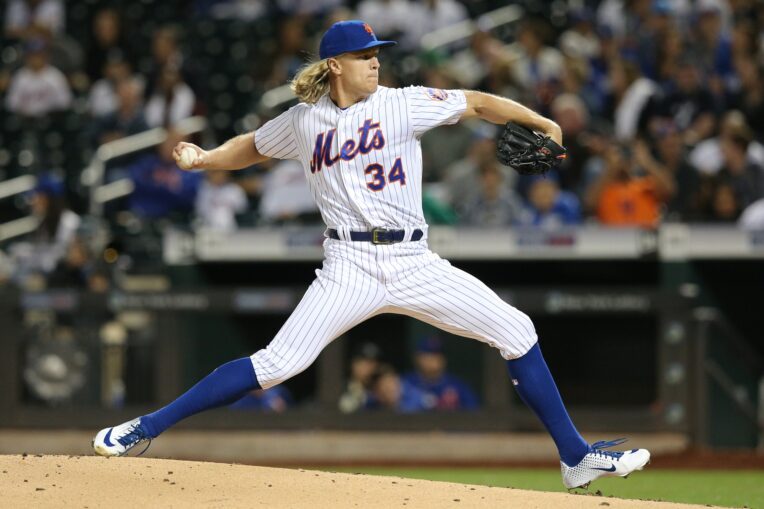
The New York Mets are preparing for the 2020 MLB regular season with a roster strength we’ve gotten used to hearing about: the starting rotation.
Sure, the staff took a hit when Zack Wheeler left via free agency and general manager Brodie Van Wagenen filled the void by signing Michael Wacha and Rick Porcello. But with a top three of Jacob deGrom, Noah Syndergaard, and Marcus Stroman in place, this area should once again be a strength for New York.
With Wheeler’s departure to the Philadelphia Phillies, it makes the performance of those top three in Queens more important, and especially when looking toward Syndergaard. His 4.4-fWAR performance from 2019 was the third time he’s produced at least 4.0 fWAR in a season since debuting in 2015.
However, it was only slightly better than his 2018 performance (4.2 WAR) despite throwing 40-plus more innings this past year. Couple in an uncharacteristic rise in ERA (3.03 in ’18, 4.28 in ’19), and it’s clear to see why the most recent campaign wasn’t the smoothest we’ve seen from the big right-hander throughout his young MLB career.
A glimpse into Syndergaard’s offseason workout makes it appear that he’s treating the upcoming season as incredibly important, not just for the Mets overall, but also for the hurler on a personal level. He’s under team control through 2021, so one has to imagine there’s a chance of extension talks taking place next winter if he gets back to his consistent dominance in the next few months.
When looking back at certain stats and trends from 2019, here are four areas that will be key for Syndergaard moving forward.
Slider Usage and Effectiveness
Between 2015 and 2018, Syndergaard’s slider has consistently been one of his best weapons. That’s evidenced by opponent wRC+, which looked like this over that period of time: -2, 24, -2, and 32. After throwing it at a 2.1% clip as a rookie, the righty’s usage has then hovered around the 20.0% mark.
Although opposing hitters still didn’t do exceptionally well against the offing in 2019 (66 wRC+), it was much better than in recent years, along with his season-long usage rate of 15.2% being quite low. If we split out the usage rates and value of Syndergaard’s slider between the first and second half, though, there was a clear trend going on (wSL/C is the pitch’s value on a per-100-pitch basis).

Of course, the spike in slider usage wasn’t just unique to Syndergaard — the majority of the Mets’ rotation also did the same thing. Maybe this took place because New York’s starters finally got a feel for the baseball, or maybe not. Whatever the reasoning was behind this boost in pitch performance, it needs to continue for Thor heading into next year.
Performance at Home
When looking at his career statistics, Syndergaard’s home ERA (3.31) and road ERA (3.30) are virtually identical. It’s only that way right now because of what happened this past year, though. Between 2015 and 2018, the 27-year-old never watched his Citi Field ERA crest above 2.87 in a single season. Yet, it settled in at 5.02 this past year in Flushing, while his 3.40 road ERA helped even out his season-long performance.
Of the 24 homers he allowed last year, 17 came at Citi Field, a situation that also yielded a higher walk rate (7.2%), WHIP (1.31), and strand rate (67.1%) than what he accomplished on the road (4.6%, 1.14, 71.0%, respectively). This likely happened because there were a handful of home starts where Syndergaard struggled that inflated his ERA: April 27th against the Milwaukee Brewers (five runs in five innings), May 24th against the Detroit Tigers (six runs in 5.1 innings), and August 28th against the Chicago Cubs (10 runs — nine earned — in three innings).
Citi Field has consistently been one of baseball’s most pitcher-friendly parks, with 2019 following suit. Syndergaard has typically taken advantage of that during his tenure with the Mets, and it’s not outrageous to think it’ll get back to normal in 2020.

Keeping Walk Rate Low
If we take a look at Syndergaard’s year-to-year progression in walk rate since debuting, it’s been rather consistent. His career mark is currently 5.7%, and his yearly numbers since ’15 read as follows: 5.1%, 5.8%, 2.4%, 6.1%, and 6.1%.
So, his walk rate over the past two seasons has been identical, but when we break down his 2019 performance into a monthly view, it was a little bit more of a rollercoaster. It was elevated more than usual over the season’s first three months, but then started dropping from June to the end of the regular season. Here’s how his monthly percentages shook out: 6.8%, 4.2%, 9.5%, 7.2%, 5.0%, and 4.7%.
While his monthly ERA numbers weren’t consistently low throughout the second half, everyone would much rather take Syndergaard’s post-All-Star Game strikeout and walk rate numbers (26.4% and 5.2%, respectively) than the pre-All-Star Game numbers (22.8% and 6.8%).
Controlling Quality of Contact
After starting his career with a strikeout rate flirting with 30.0% on a consistent basis, Syndergaard’s whiff rate has settled in around 24.0% over the past two seasons. With that in mind, it’s important for him to control the quality of contact from opposing hitters, which is what’s happened recently.
In 2018, his 25.3% soft-hit rate and 21.9% hard-hit rate allowed were among the best in baseball when looking specifically at qualified starters. He remained among the league leaders in 2019 with a 21.5% soft-hit rate allowed and a 29.1% hard-hit rate allowed, but both those numbers were quite different from the year prior.
This skill of Syndergaard goes hand-in-hand with some of the other keys mentioned here. Limiting his walk rate will help with his run prevention efforts while upping the effectiveness of his slider will undoubtedly aid in controlling the quality of contact. And with fewer runners on base, it’d hypothetically be easier to strand the ones that do reach base at the same level he’s been at during other years in his career.
Syndergaard is already projected to be incredibly valuable to the Mets in 2020, but the levels currently set for him are benchmarks he’s already hit consistently. It’ll be interesting to see how he can push past those projections and reach yet another level in his age-27 campaign.















